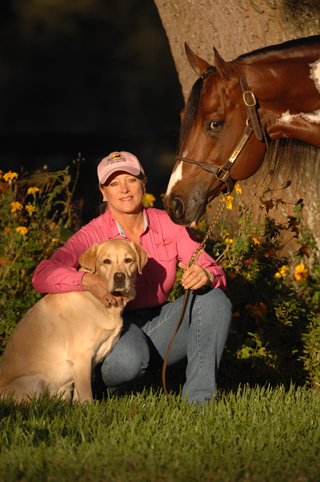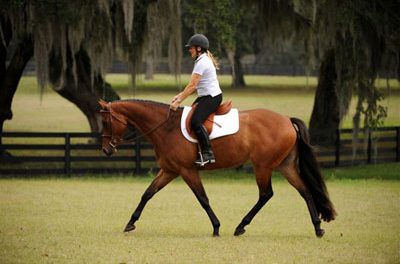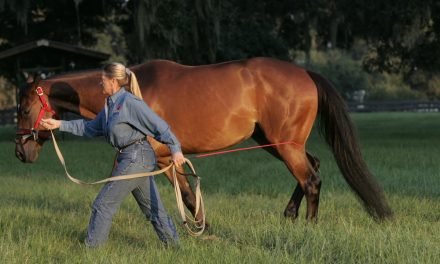BUILDING A PARTNERSHIP WITH YOUR HORSE
 This month’s article is the second in a series based on part two of my five-part visual series, “Dressage Principles for the Western and English Horse and Rider.” This section is titled “Communicating with Your Aids…Keys to Success” because I believe that it contains the lessons every rider needs to create a responsive and willing horse.
This month’s article is the second in a series based on part two of my five-part visual series, “Dressage Principles for the Western and English Horse and Rider.” This section is titled “Communicating with Your Aids…Keys to Success” because I believe that it contains the lessons every rider needs to create a responsive and willing horse.
Last month I discussed the importance of a horse that stands still while the rider mounts and the rider’s responsibilities during the mounting process. In this article I will give you more advice on how to mount safely.
I know that this seems very basic to many of you, but a horse that does not stand still for mounting can be a safety problem! Also, if a horse is allowed to be disobedient in his basic training, he probably will only get worse as his training progresses. At the same time, not all mounting problems are due to intentional disobedience. If the horse jigs around when you want to mount, he may be thinking too fast and walking away in anticipation of your cue to go forward once you are mounted. More likely, however, he is trying to catch his balance because you are not mounting him properly.
I suggest that you start using a mounting block. These are inexpensive, plastic, step-like platforms made to give a rider an elevated surface from which to mount. Because the mounting block will put you higher off the ground it will be easier to swing your leg over the horse to mount. Mounting blocks also decrease the stress put upon the horse’s back from riders who pull themselves up into the saddle. They also are helpful for smaller riders when they are mounting a large horse.
To reinforce the mounting lesson, mount your horse in the same location every time you ride. Choose a spot where you can position the horse between a fence and the mounting block. The fence will help him stay straight and focused. Ask him to stand “square.” This means positioning him so that his weight is equally distributed on all four legs and his hooves are like the four corners of a rectangle.
Ask your horse to “whoa,” and step up on the mounting block as if you were going to get up on him, but do not mount. Because you will be standing above his top line, he may need some time to accept you in this new elevated position. He also may move, anticipating that you will be mounting and that he will need to balance himself. If he moves, calmly reposition him and repeat this step. Take time for this step, and do not proceed until he is relaxed.
Practice the mounting procedure using the block, and at the same time teach your horse that mounting does not mean for him to move forward. Position him in the mounting spot and ask him to “whoa” by putting a slight tension on the reins. Place the reins over his neck, being careful to maintain the same amount of tension in each rein. Riders have a tendency to pull on the left rein while mounting, causing their horse to circle towards them. This makes getting on even more difficult.
To prevent pulling on the reins, keep your hands in front of the saddle. If the horse wants to move as you attempt to mount, avoid walking him in a circle to get back into position as this will only reinforce that mounting means it is okay to move forward. Instead, stop him and back him up to the block or reposition the block next to him.
Once your horse is in position, step up onto the block and gather up the reins by sliding your left hand on the horse, starting at the buckle and moving up on the horse’s neck. While holding the reins, move your left hand so it is grasping the front of the saddle as you place your right hand on the saddle’s cantle. Put your left foot in the stirrup and start to mount, but just swing your leg halfway over his back, and then dismount. Praise your horse when he stands still. Do this several times. You may need to repeat this lesson over several days or weeks until he understands that mounting does not mean for him to move forward.
When your horse shows that he is willing to stand perfectly still for the half mount, swing your leg over his back. As you do, transfer your right hand from the cantle to the saddle’s pommel to help you balance. Then, sit down on his back as softly as possible. Mounting in this manner, without pulling the saddle across his back, will encourage him to stand still.
Use the mounting block until you build up the strength in your arms and legs that will allow you to mount from the ground. Most mounting blocks have two steps. Practice mounting from the top step, and then graduate to the lower step as your strength improves. Eventually, you will be able to mount from the ground, but continue to use the same mounting spot so that your horse understands to stand still.
In the next article, I will cover including a warm-up session in your routine.
Lynn Palm teaches and coaches riders and horses. She also develops training and educational products. From April 3 – 5, 2008, she will be hosting her East Coast Women LUV Horses program in Ocala, Florida. Learn more on Lynn’s Web site at www.lynnpalm.com.





